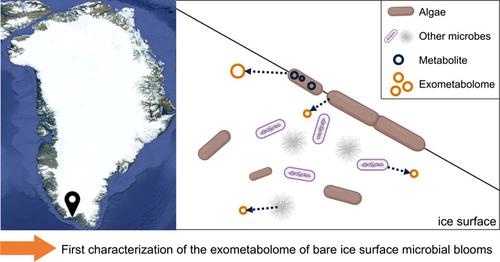当前位置:
X-MOL 学术
›
Environ. Microbiol.
›
论文详情
Our official English website, www.x-mol.net, welcomes your feedback! (Note: you will need to create a separate account there.)
The exometabolome of microbial communities inhabiting bare ice surfaces on the southern Greenland Ice Sheet
Environmental Microbiology ( IF 5.1 ) Pub Date : 2024-01-23 , DOI: 10.1111/1462-2920.16574 Eva L. Doting 1, 2 , Marie B. Jensen 1 , Elisa K. Peter 3, 4 , Lea Ellegaard‐Jensen 1 , Martyn Tranter 1 , Liane G. Benning 3, 4 , Martin Hansen 1 , Alexandre M. Anesio 1
Environmental Microbiology ( IF 5.1 ) Pub Date : 2024-01-23 , DOI: 10.1111/1462-2920.16574 Eva L. Doting 1, 2 , Marie B. Jensen 1 , Elisa K. Peter 3, 4 , Lea Ellegaard‐Jensen 1 , Martyn Tranter 1 , Liane G. Benning 3, 4 , Martin Hansen 1 , Alexandre M. Anesio 1
Affiliation

|
Microbial blooms colonize the Greenland Ice Sheet bare ice surface during the ablation season and significantly reduce its albedo. On the ice surface, microbes are exposed to high levels of irradiance, freeze–thaw cycles, and low nutrient concentrations. It is well known that microorganisms secrete metabolites to maintain homeostasis, communicate with other microorganisms, and defend themselves. Yet, the exometabolome of supraglacial microbial blooms, dominated by the pigmented glacier ice algae Ancylonema alaskanum and Ancylonema nordenskiöldii, remains thus far unstudied. Here, we use a high-resolution mass spectrometry-based untargeted metabolomics workflow to identify metabolites in the exometabolome of microbial blooms on the surface of the southern tip of the Greenland Ice Sheet. Samples were collected every 6 h across two diurnal cycles at 5 replicate sampling sites with high similarity in community composition, in terms of orders and phyla present. Time of sampling explained 46% (permutational multivariate analysis of variance [PERMANOVA], pseudo-F = 3.7771, p = 0.001) and 27% (PERMANOVA, pseudo-F = 1.8705, p = 0.001) of variance in the exometabolome across the two diurnal cycles. Annotated metabolites included riboflavin, lumichrome, tryptophan, and azelaic acid, all of which have demonstrated roles in microbe–microbe interactions in other ecosystems and should be tested for potential roles in the development of microbial blooms on bare ice surfaces.
中文翻译:

格陵兰冰盖南部裸冰表面微生物群落的外代谢组
在消融季节,微生物大量繁殖,在格陵兰冰盖裸露的冰表面上繁殖,并显着降低其反照率。在冰表面,微生物暴露在高强度的辐照、冻融循环和低营养浓度下。众所周知,微生物分泌代谢物来维持体内平衡、与其他微生物沟通并保护自身。然而,以色素冰川冰藻Alaskanum和Nordenskiöldii为主的冰上微生物繁殖的外代谢组迄今为止仍未得到研究。在这里,我们使用基于高分辨率质谱的非靶向代谢组学工作流程来识别格陵兰冰盖南端表面微生物繁殖的外代谢组中的代谢物。在两个昼夜周期中每 6 小时在 5 个重复采样点收集样本,这些采样点在群落组成、目和门方面具有高度相似性。采样时间解释了 两者外代谢组差异的 46%(排列多元方差分析 [PERMANOVA],伪F = 3.7771,p = 0.001)和 27%(PERMANOVA,伪F = 1.8705 , p = 0.001)昼夜循环。注释的代谢物包括核黄素、发光色素、色氨酸和壬二酸,所有这些都已证明在其他生态系统中微生物-微生物相互作用中发挥作用,并且应该测试其在裸冰表面微生物繁殖发育中的潜在作用。
更新日期:2024-01-23
中文翻译:

格陵兰冰盖南部裸冰表面微生物群落的外代谢组
在消融季节,微生物大量繁殖,在格陵兰冰盖裸露的冰表面上繁殖,并显着降低其反照率。在冰表面,微生物暴露在高强度的辐照、冻融循环和低营养浓度下。众所周知,微生物分泌代谢物来维持体内平衡、与其他微生物沟通并保护自身。然而,以色素冰川冰藻Alaskanum和Nordenskiöldii为主的冰上微生物繁殖的外代谢组迄今为止仍未得到研究。在这里,我们使用基于高分辨率质谱的非靶向代谢组学工作流程来识别格陵兰冰盖南端表面微生物繁殖的外代谢组中的代谢物。在两个昼夜周期中每 6 小时在 5 个重复采样点收集样本,这些采样点在群落组成、目和门方面具有高度相似性。采样时间解释了 两者外代谢组差异的 46%(排列多元方差分析 [PERMANOVA],伪F = 3.7771,p = 0.001)和 27%(PERMANOVA,伪F = 1.8705 , p = 0.001)昼夜循环。注释的代谢物包括核黄素、发光色素、色氨酸和壬二酸,所有这些都已证明在其他生态系统中微生物-微生物相互作用中发挥作用,并且应该测试其在裸冰表面微生物繁殖发育中的潜在作用。



























 京公网安备 11010802027423号
京公网安备 11010802027423号